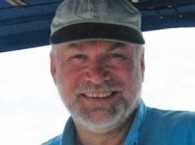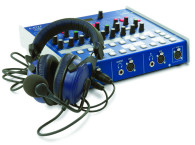
Shannon Becker: Tell us a little about your background and where you live.
Daniel Weiss: I live in Uster, a small city close to Zurich in Switzerland. In the 1970s and 1980s, I played music in a band, first as a violin player and later as the bass guitarist, which seemed preferable to the other band members. I also built various synthesizers, amplifiers, and speakers. I did a four-year apprenticeship as an electronics technician and during that time two friends and I formed a company called “White Amplifiers.” We built amplifiers and speakers for musicians in our spare time. After the apprenticeship, I studied electronics engineering and eventually graduated with a BSEE.
Shannon Becker: In 1979, you joined Studer-Revox as an electronics engineer working in the digital audio lab. Can you share details regarding your work on the sampling frequency converter design?
Daniel Weiss: In 1979, Willi Studer decided to enter the digital audio era and established the “PCM laboratory” with almost all the lab members being newly recruited engineers and technicians. We were kind of an isolated group as the other labs were slightly suspicious of digital audio technology. We also had a hard time (at least it seemed to me) defining digital audio products that would make sense in a mainly analog world.
There were several digital audio recorders around at the beginning of the 1980s (e.g., Sony, 3M, Soundstream, JVC, Mitsubishi, etc.). There wasn’t much standardization back then so the sampling rates and interface formats greatly varied. Thus, it made sense to create a universal sampling rate converter with custom wired interfaces. This became the SFC16, and I did most of the hardware design. It was a 6HU/19” unit with digital filters built in so-called distributed arithmetic. It is a very clever architecture that avoids the need for DSP or multiplier chips. For most of the units sold—I think 30 of them were manufactured—I also did custom interfaces.
Shannon Becker: What other types of audio products did you design? Can you share some of the challenges involved with the design(s)?
Daniel Weiss: My colleagues at the PCM lab pursued various other projects, such as A/D and D/A design, analog reconstruction filter design (I also was involved), research in de-noising, and a preview unit for the delay required in vinyl cutting. This resulted in a A/D and D/A 6HU box, with enough memory to do the delay. It was not a simple task back then.
As Studer was mainly a tape recorder company, the design of a digital tape recorder was inevitable. The first model was an eight-channel unit using the newly established Digital Audio Stationary Head (DASH) format, which enabled you to interchange tapes with ones recorded on other DASH recorders. I did the audio processing unit for that eight-channel recorder, which was required for interpolation in case the data read from the tape could not be reconstructed via the error correction scheme employed.
Those were interesting times at Studer, as we were pioneers in the pulse code modulation (PCM) audio field. We did many side projects, such as a digital sine generator for measuring purposes (Audio Precision did not exist back then) or a study on TIM measurements with a new approach or a PWM-based analog track on the digital tape and so forth.

Shannon Becker: In 1985 you founded your own company, Weiss Engineering (www.weiss.ch). Initially, your company focused solely on designing and manufacturing digital audio equipment for mastering studios. How and why did you select that specific market niche?
Daniel Weiss: One day in 1984, when I still was at Studer, a customer came to our lab and asked for an interface between a Sony F1 portable digital audio recorder and a Sony 1610 digital audio recorder. The F1 did not have any digital I/O, so it had to be a custom made interface box. Studer does not do such custom work, so I made that interface for the customer in my spare time. The customer was Ben Bernfeld, a recording and mastering engineer from Harmonia Mundi Acustica in Germany. He knew exactly what was required in terms of equipment for CD mastering (or pre-mastering to be exact). So we decided to build a modular digital audio system to interface and process digital audio. I did the design and manufacturing while he organized the sales. CD pre-mastering was popular in the US mainly, so we concentrated on that market.
Shannon Becker: Tell us about Weiss’s first product. Is it still being sold today?
Daniel Weiss: The first system became the Harmonia Mundi Acustica BW-102 unit, starting with modules for F1, 1610 interfacing, a digital high-pass filter for DC offset elimination, a digital de-emphasis and a digital level control module.
Over the years, dozens of modules were added. We even did digital mixing consoles based on the BW-102. The largest one was a 32-channel console with four auxiliary buses. Another one was a 24-channel configuration with GML fader automation used by Sony Classical in New York. Those consoles were a bit awkward in terms of hardware requirements, because the BW-102 initially was designed for two-channel applications. Later, we also upgraded most of the modules to handle 96 kHz. Quite a few customers still use the BW-102, we even occasionally sell modules. Technically it is still up-to-date with 96/24 capability and 32-bit floating point processing.
After the BW-102, we started the Gambit Series with 19” units (e.g., analog to digital, digital to analog, parametric equalizer, dynamics processor, de-noiser/de-clicker, sampling rate converter, and more).


Shannon Becker: In 2000, Weiss entered the high-end consumer audio market with a new product line. What was the impetus behind that decision
Daniel Weiss: We thought that our DAC1 DAC could find a market within the high-end community. So we built the Medea DAC, based on the DAC1, to test the waters. The Medea became a huge success and it did not take long for customers to ask for more. So we built the Jason CD transport to complement the Medea. Other high-end products followed, up to the latest one, the MAN301 network player.
Shannon Becker: With the two separate aspects of your company—professional equipment for mastering studios and high-end consumer products—you are in the unique position of controlling, in part, the “production” of the masters and their reproductions. Do you think there is a direct correlation between the two worlds?
Daniel Weiss: Correlation maybe in that both mastering engineers and audiophiles are interested in getting top notch sonic quality and ergonomics. We can use our design philosophy — with the utmost transparency — with both markets. But in the end, we simply supply tools. The mastering engineer needs to know how to use them properly.
Shannon Becker: To what do you attribute your company’s continuing success?
Daniel Weiss: At first, it was the fact that we built the right product at the right time (i.e., when the CD took off there was a huge demand for decent audio processing in the digital domain). In the consumer market, I think our customers like our “no bull” approach. I don’t hold back with my opinions about $1,000 mains cords, gold-plated fuses, small wood blocks for acoustics treatment, or CD demagnetizing, and so forth. I wrote some white papers firmly based on the laws of physics on various audio topics in an attempt to fight the snake oil with facts. This is something I like about the pro audio people, they are down-to-earth guys.
Shannon Becker: Tell us about your favorite high-end consumer product? What makes it different from other products on the market today?
Daniel Weiss: One of my favorites is the MAN301 network player—from our product line, of course. It is an incredibly versatile unit for CD playback and ripping, and metadata tagging/artwork. It uses the Gracenote database and this is hardly seen on any other high-end network player. It also includes file playback (including DSD), DAC, preamplifier functions, and so forth. I use one at home and enjoy it every day. We continue to develop additional software for the MAN301 (e.g., for room equalization, creative equalization, vinyl simulation, and so on).
I also like to listen to as many different speakers as possible to explore the various philosophies and designs. I think the speaker/room system has, by far, the greatest potential for improvement of the whole audio chain. Audiophiles should acknowledge that and stop messing around with mains cords. The industry still has a long way to go when it comes to speaker/room optimization.

Shannon Becker: Could you share your opinion on mastering for digital file distribution and, in particular, the mastering for iTunes initiative?
Daniel Weiss: If it is mastering for an uncompressed format, then the procedure should not be different from a standard CD mastering—except maybe if the format is at a higher sampling rate and/or word length than for a CD.
Mastering for iTunes is different, as it means mastering for a lossy format (for the time being at least). But I think the best thing about that initiative is Apple imposes specific criteria on the technical quality of the supplied music, in particular that the music must not be clipped. There are also a number of recommendations available at http://images.apple.com/itunes/mastered-for-itunes/docs/mastered_for_itunes.pdf.
Shannon Becker: Where do you see the audio market headed in the next five years? Do you think we will eventually evolve to “high-end” streaming audio services rather than downloading files?
Daniel Weiss: There always will be both variants. Many people like to “own” the music so they can play it anytime and anywhere. And, I think the emotional relationship to the music is different if you’ve got it “on file” and not just via a stream. Streaming services are great to check out new music. They should have a “buy” button on their websites though. Streaming during travel can get expensive and/or can be annoying when the stream gets disrupted in the tunnel or because of too many people try to get streams on a train, for instance.
Also it seems that for artists streaming services are far from lucrative. That could be changed maybe if they would simplify the buying process right from the streaming site. In any case, the majority of high-end playback systems will use computer-based playback devices because it is so much more convenient and easily enables people to discover new music from streaming services or even in their own libraries.






